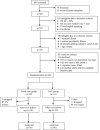An Intervention to Enhance Goals-of-Care Communication Between Heart Failure Patients and Heart Failure Providers
- PMID: 27401505
- PMCID: PMC5545129
- DOI: 10.1016/j.jpainsymman.2016.03.018
An Intervention to Enhance Goals-of-Care Communication Between Heart Failure Patients and Heart Failure Providers
Abstract
Context: Heart failure patients contend with a markedly impaired quality of life, experiencing emotional distress and severe physical discomfort that increases in frequency in the last months of life. Improving communication between patients and providers about goals of care has the potential to improve patient-provider communication and patient outcomes.
Objectives: To determine the effects of a goals-of-care (GoC) intervention compared to usual care on the number of GoC conversations, quality of communication between patients and providers, referrals to palliative care services and completion of advance care directives.
Methods: A two-group randomized study (n = 40/group) compared a GoC intervention to usual care, conducted in an academic heart failure (HF) clinic. The GoC intervention was a previsit patient activation-education, telephone-based intervention delivered by a nurse. The primary outcome of the study was number of GoC conversations between HF patients and HF providers. Secondary outcomes were quality of communication, number of referrals to palliative care, and completion of advance directives.
Results: Patients averaged 58.15 ± 11.26 years of age, with mean left ventricular ejection fraction = 30.31 ± 9.72% and Seattle Heart Failure Model scores = 95.1 ± 1.60. There was a significant increase in goals-of-care conversations (58% vs. 2.6%, P < 0.001) and quality of end-of-life communication (P = 0.03) in the GoC group compared to usual care after the intervention. There were no differences between groups on the other outcomes.
Conclusion: The GoC intervention resulted in more GoC conversations and higher quality communication between HF patients and providers without increased anxiety or depression. Further studies are needed to assess impact on longer term quality of care and patient outcomes.
Trial registration: ClinicalTrials.gov NCT02466100.
Keywords: Goals of care; communication; end of life; heart failure; palliative care.
Copyright © 2016 American Academy of Hospice and Palliative Medicine. Published by Elsevier Inc. All rights reserved.
References
-
- Mozaffarian D, Benjamin EJ, Go AS, et al. Heart disease and stroke statistics-2016 update: a report from the American Heart Association. Circulation. 2016;133:e38–e60. - PubMed
-
- Pantilat SZ, Steimle AE. Palliative care for patients with heart failure. JAMA. 2004;291:2476–2482. - PubMed
-
- Liao L, Anstrom KJ, Gottdiener JS, et al. Long-term costs and resource use in elderly participants with congestive heart failure in the Cardiovascular Health Study. Am Heart J. 2007;153:245–252. - PubMed
-
- Whellan DJ, Goodlin SJ, Dickinson MG, et al. End-of-life care in patients with heart failure. J Card Fail. 2014;20:121–134. - PubMed
-
- Sahlen KG, Boman K, Brannstrom M. A cost-effectiveness study of person-centered integrated heart failure and palliative home care: based on a randomized controlled trial. Palliat Med. 2016;30:296–302. - PubMed
Publication types
MeSH terms
Associated data
Grants and funding
LinkOut - more resources
Full Text Sources
Other Literature Sources
Medical
Research Materials
Miscellaneous


